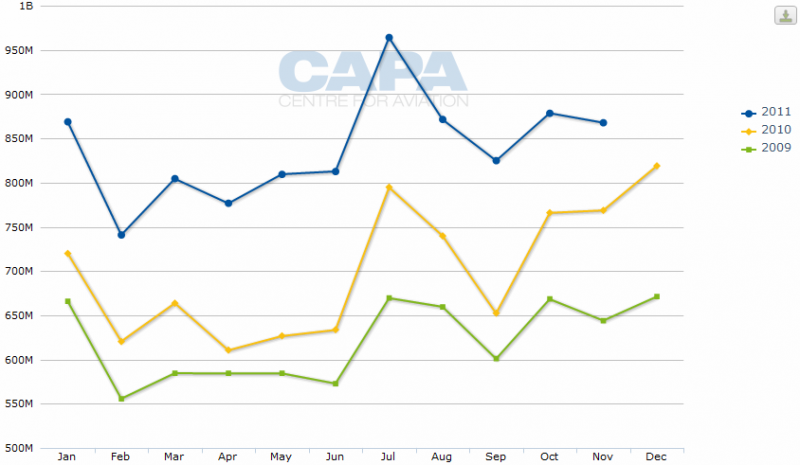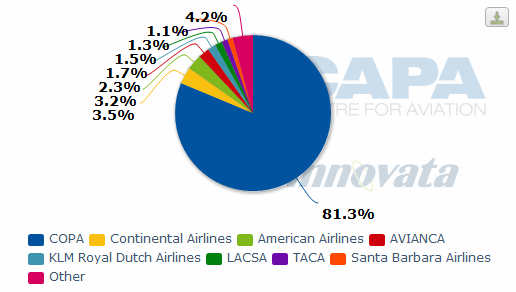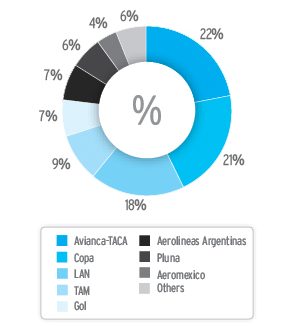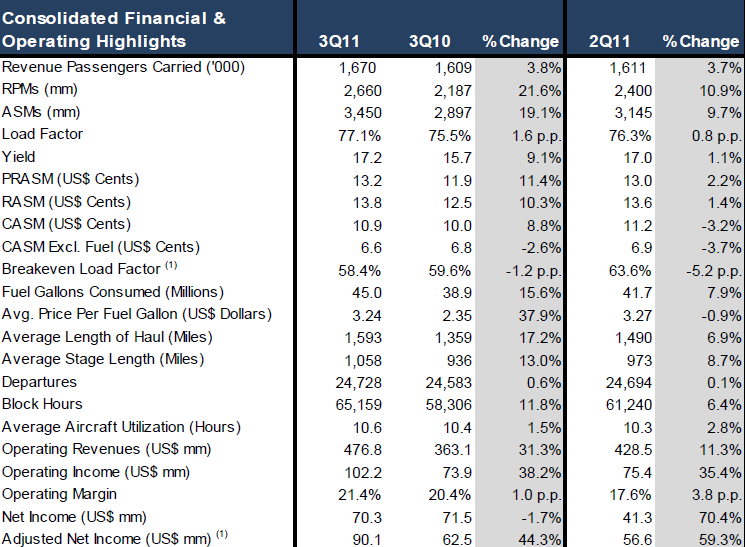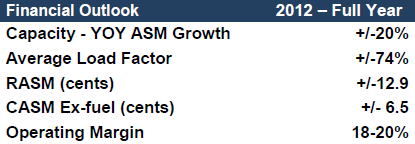New tax on transit passengers could lead to slower growth at Panama’s Tocumen Airport and Copa
Panama City Tocumen International Airport is planning to introduce in 2012 a transit tax that threatens to impact demand and slow down growth at the biggest hub for intra-Latin America travel. Copa Airlines, which relies heavily on transit traffic to generate one of the aviation industry's highest profits margins, is fighting the planned tax along with IATA.
Transit passengers at Tocumen are currently exempt from paying departure tax, as is the case at airports throughout Latin America and the world. But government-owned Tocumen is planning to introduce a USD2.50 transit tax while raising the current USD40 departure tax to USD42.50.
While USD2.50 is a relatively small amount and would generate only about USD6 million per year, Copa and IATA are vehemently opposed to the concept of taxing transit traffic. The fear is the tax, if implemented, would increase over time, significantly impacting demand. Tocumen three years ago doubled the departure tax from USD20 to USD40, setting a precedent for a rapid rise in fees which could be repeated with the initially small transit tax.
- Panama City Tocumen International Airport plans to introduce a transit tax in 2012, which could impact demand and slow down growth at the biggest hub for intra-Latin America travel.
- Transit passengers at Tocumen are currently exempt from paying departure tax, but the airport plans to introduce a USD2.50 transit tax while raising the current USD40 departure tax to USD42.50.
- Copa Airlines, which heavily relies on transit traffic, is fighting against the planned tax along with IATA, as they fear it could significantly impact demand and potentially jeopardize Tocumen's position as the leading hub for intra-Latin America travel.
- Transit passengers account for about 40% of Tocumen's traffic and about 50% of Copa's Panama City traffic, making it a crucial segment for both the airport and the airline.
- The new tax could potentially sway passengers to transfer at rival Latin American hubs, impacting Copa, Tocumen, and retailers as fewer transit passengers mean fewer opportunities for duty-free sales.
- Tocumen is already highly profitable and does not need the extra tax to pay for further airport upgrades. The airport should focus on growing its retail business to take advantage of the large and fast-growing captive audience that Copa brings.
Transit passengers account for about 40% of Tocumen's traffic and about 50% of Copa's Panama City traffic, or approximately 2.5 million passengers annually. Copa for years has touted the advantage of Tocumen, which does not face the infrastructure challenges plaguing other Latin American hubs and offers a smooth transfer product. But a transit tax would offset some of this advantage and could jeopardise Tocumen's position as the leading hub for intra-Latin America travel. The tax could also potentially impact Copa's yields if it needs to lower fares to keep passengers from using other hubs.
IATA director general Tony Tyler says Copa's Panama City hub is "geographically well situated" for connecting passengers within Latin America and taxing transit passengers would "constrain" Copa. Speaking at a small media briefing last month, Mr Tyler said "it's really a tax on growth and a tax of the hub". He added: "It's a shocking position that an airline can't be moderately successful without being a target."
Copa CEO Pedro Heilbron, who discussed the transit tax with Mr Tyler during last month's ALTA Airline Leader Forum in Brazil, said on the sidelines of the Forum that there is "a lack of understanding on how [the tax] can affect the competiveness of the airport". Copa and IATA have since quietly been trying to explain to Panama's government-owned airport authority the benefits of not implementing a tax on transit passengers. But so far their pleas have fallen on deaf ears.
The new tax could sway some passengers to transfer at rival Latin American hubs such as Bogota and Lima. This would impact Copa, Tocumen and retailers as fewer transit passengers mean fewer opportunities for duty free sales.
Copa expects traffic to grow by another 20% in 2012
Copa has been growing at a rapid clip over the last several years, driven by rising demand for travel within Latin America and the Caribbean. Copa's passenger traffic (RPMs/RPKs) through the first 11 months of this year increased 21%, including a 27% spike in international traffic. In 2010, the group's RPM/RPKs were up 14%.
Mr Heilbron expects the group, which includes Panama-based Copa and sister carrier Copa Colombia, will grow its traffic by a further 20% in 2012 as 10 more aircraft are added to the fleet.
Copa monthly RPMs: Jan-2009 to Nov-2011
As Copa has grown, Tocumen has benefited. Tocumen in 2010 recorded a 6% increase in total traffic to 5 million passengers, including an 8% increase in transit traffic to 2.1 million passengers. This year the growth has accelerated significantly with total traffic through the first seven months of 2011 up 15% to 3.3 million passengers. Transit traffic through the first seven months of 2011 jumped by 24% to 1.4 million passengers.
Transit traffic for the full year 2011 is now on track to exceed 2.5 million, roughly double the 1.3 million recorded only four years ago in 2007. Total traffic at Tocumen for the full year 2011 is expected to come in at about 6 million passengers, representing a doubling of throughput in less than six years as the airport only handled 2.8 million passengers in 2005.
Tocumen Airport monthly transit traffic and total traffic: Jan-2009 to Jul-2011

Copa accounts for 81% of total capacity at Tocumen, based on current capacity data from Innovata. Copa has virtually no low-cost competition because only one LCC currently serves Panama City - Spirit Airlines - which operates four weekly flights from Fort Lauderdale.
Panama City capacity by carrier (seats per week): 19-Dec-2011 to 25-Dec-2011
More passengers transit at Panama City than any other Latin American hub
While it is only the sixth largest Latin American airline group by revenue and accounts for only 4% of total capacity among the region's carriers, Copa is a leading player in the increasing important intra-Latin America market. Copa currently accounts for 21% of all international capacity within Latin America. Low-cost carriers account for only 2% of capacity in this market, which partly explains the relatively high fares in the intra-Latin American international market and Copa's high profit margins (in recent years Copa's annual operating profit margin has been in the 17% to 20% range).
Larger airline group Avianca-TACA accounts for a slightly larger share of capacity in the international intra-Latin America market, 22%. But Avianca-TACA's capacity is spread across four hubs - Bogota, Lima, San Jose and San Salvador - while nearly all of Copa's international capacity is concentrated at Panama City (the only exception is a handful of international routes from Bogota to Ecuador, Mexico and Venezuela).
In addition, a much smaller portion of Avianca-TACA's traffic is transit compared to Copa. LAN is much larger than both Copa and Avianca-TACA but is smaller in the intra-Latin America international market with an 18% share of capacity. LAN relies more on long-haul international traffic and domestic traffic than Copa or Avianca-TACA. LAN currently operates in five domestic markets compared to three for Avianca-TACA and one for Copa.
Intra-Latin American international market capacity share by airline group
Copa's "hub of the Americas" now connects more than twice as many destinations as any of the other five intra-Latin America airline hubs - LAN's Lima hub and Avianca-TACA's hubs in Bogota, Lima, San Jose and San Salvador. As a result, Copa has dozens of unique intra-Latin American city pairs which are not served by any other carriers on a one-stop basis. Copa says 74% of its city pairs currently have 20 or fewer daily passengers.
On the city pairs where it does have competition, Copa offers significantly more frequencies. Copa now operates two or more daily flights on about half of its routes from Panama City, while more than half of the international routes from Bogota, Lima, San Jose or San Salvador are served with one or fewer daily frequencies.
Terminal expansion widens gap between Tocumen and other airports
In Jun-2011 Copa added two banks of flights at Tocumen, giving its hub a total of six banks - more than twice as many as any of the competing hubs. The new banks resulted in improved connection times for many of Copa's existing city pairs, further distancing the gap between Tocumen and other Latin American hubs.
Tocumen's advantage over other Latin American hubs will further widen within the next few weeks when Tocumen opens a terminal expansion which will add 12 gates for a total of 34 air bridges. This will give Tocumen more than twice as many international gates compared to any competing hub in Latin America. Speaking to analysts last month, Mr Heilbron said the additional jet bridges along with the new six bank hub "will allow us to continue expanding without gate constraints for several years. We're also working on several initiatives to improve our passenger experience and consolidate our leadership as the preferred airline for intra-Latin American travel".
Further airport expansion is already on the drawing board to ensure Tocumen keeps ahead of the growth curve and remains the standout in a region with growing infrastructure problems. But Tocumen is now in danger of also having the distinction of charging the highest fees and taxes in the region. Having the best product does not mean the airport will be able to get away with charging higher fees or introducing taxes that are not levied by other airports in the region. Passengers are price sensitive and typically choose the least expensive option even if that means flying through an airport that is more congested and has longer connection times.
Transit passengers seem like an easy target for a new tax because Copa and Panama City offers the best connections for many passengers travelling within the Americas. But most of these passengers do have the option of travelling via other hubs. As Avianca-TACA and LAN continue to expand, there will also be more options for these passengers. Copa is by no means in a monopolistic position and any increase in the cost of transferring via Panama City will have an impact.
Tocumen is already highly profitable
Tocumen is already heavily profitable and does not need the extra tax to pay for further airport upgrades. In its last financial report, for 2009, Tocumen reported a pre-tax profit margin of 47%. It is believed Tocumen continues to have an operating profit margin of about 50%.
Tocumen should be able to maintain its high level of profitability without increasing taxes or fees or introducing a new tax on transit passengers. The airport instead should focus on growing its retail business to take advantage of the large and fast-growing captive audience that Copa brings to the airport.
Copa's profit margin, which in recent years has been one of the highest in the airline industry, could make the airline a target for higher charges. But the airline's margin is still thin compared to many airports and the Panamanian Government needs to recognise how further rapid growth at the airline will help ensure further rapid growth at Tocumen and in the country's overall economy.
Panama's booming economy to drive growth in local traffic
Tocumen will be able to rapidly increase its revenues without introducing a tax on transit passengers because local traffic is also expected to grow rapidly in Panama. In recent years Tocumen's transit traffic has grown faster than local traffic but equally rapid growth for both sectors is likely given the expected growth in Panama's economy. Even with 20% annual traffic growth at Copa over the next year years, it is feasible to expect 20% growth in both local and transit traffic given the strength of the local Panamanian market.
The Panamanian economy is currently the fastest growing in all of Latin America, driven by the expansion of the Panama Canal and other major infrastructure projects. Panama is expected to record GDP growth of 8% to 9% in 2011 and GDP growth again approaching 10% in 2012. Panama's economy is expected to be the fastest growing in Latin America over the next five years.
The new free trade agreement between the US and Panama could accelerate growth even further. Copa, given its 80% plus market share in Panama, is uniquely positioned to benefit from Panama's continued growth. An increase in the departure tax may slightly slow down demand as discretionary leisure travel becomes more expensive but would likely not have an impact on business travel to/from Panama.
Rapid growth in intra-Latin America market to drive growth in transit traffic
Copa is also well positioned to benefit from continued growth in the overall Latin American economy. The international intra-Latin America passenger market grew by 14% in 2010 and by another 9% through the first 10 months of this year, according to RPK data from Latin American airline association ALTA. It is expected to continue to be one of the world's hottest growth markets but Copa can only continue to cash in on this growth if Tocumen is competitive with the region's other hubs.
Copa needs a continued healthy mix of transit and local traffic to support further network growth. While Panama's economy is booming, it is a small market of only four million people and cannot support a large network without the transit component.
Copa launched a record nine routes in 2011
Copa was able to launch this year a record nine new routes from Panama City, with the carrier committed to further growing its network if market conditions remain favourable. Mr Heilbron says there are still plenty of opportunities to expand the Panama City network, pointing out that "if Latin America keeps growing, there is still a large number of cities" that can support service. A bigger network and more frequencies would further strengthen Copa's current position in offering "the most complete and convenient intra-Latin American network".
The nine new routes launched in 2011 included four destinations that were added in June - Toronto, Nassau, Porto Alegre and Brasilia. Copa last week launched service to another five destinations - Chicago, Monterrey, Asuncion, Montego Bay and Cucuta - giving it a total of 59 destinations in 28 countries. Cucuta is Copa's ninth destination in Colombia from Panama City. The addition of Montego Bay gives Copa 12 destinations in the Caribbean while Brasilia and Porto Alegre gave Copa six destinations in Brazil.
Mr Heilbron says all the new destinations "are meeting or exceeding expectations". He says Copa previously never launched more than six new destinations. While several of the new destinations are not being served daily, Mr Heilbron expects they should all be upgraded to daily over time.
More new destinations planned for 2012
Copa is planning to launch several more new destinations next year as well as increase frequencies to a large number of existing destinations. Copa has not yet decided which new cities to serve in 2012 as the carrier typically does not add any routes until late in the second quarter. But Mr Heilbron says it will be "a little bit everywhere" as Copa continues to pursue growth both north and south.
He says Copa will once again expand its fleet in 2012 by 10 Boeing 737NGs. Copa currently operates an all-narrowbody fleet consisting of 26 E190s, 20 737-700s and 27 737-800s. It expanded its fleet from 63 to 73 aircraft this year, with seven 737-800s added to the fleet over the last five months alone. Copa plans to end 2012 with a fleet of 83 aircraft consisting of 26 E190s, 18 737-700s and 39 737-800s as 12 737-800s are delivered and two 737-700s are returned.
Copa Colombia adds third 737
Bogota-based Copa Colombia currently operates 14 of the group's 26 E190s and three of the 18 737-700s. The third 737-700 was handed from Copa (Panama) to Copa Colombia earlier this month. Copa Colombia president Roberto Junguito says the additional 737 will be used primarily to increase capacity on the core Bogota-Panama City route.
Copa Colombia operates several domestic trunk routes in Colombia but over the last two years has been increasing its focus on international services, primarily by adding capacity on routes connecting Colombia with Panama. Copa has decreased its domestic capacity in Colombia by 22% through the first 11 months of 2011. The Colombian domestic operation now accounts for less than 6% of the group's total capacity.
Copa Colombia has directed most of the capacity coming off the Colombian domestic market to international routes that feed the group's main Panama City hub. Copa Colombia also operates a few point-to-point international routes from Bogota although the main focus is on feeding Panama.
Copa aims to expand long-haul network through membership in Star
Mr Heilbron intends to continue focussing on the Panama City hub and the international intra-Latin America/Caribbean market. He also plans to stick with the group's highly successful all-narrowbody model. Copa is able to serve virtually all destinations in South and North America without any widebody aircraft due to Panama's central location in the Americas.
Instead of launching its own long-haul flights, Copa aims to extend its offline network in Asia and Europe through membership in the Star Alliance. Copa was accepted last year as a new Star member and Mr Heilbron expects the carrier to formally join Star in Apr-2012.
Panama City is currently only served by two long-haul carriers, oneworld member Iberia and SkyTeam member KLM. Mr Heilbron is hoping Panama City's fast-growing hub will start attracting Star carriers from Europe and Asia such as Lufthansa and All Nippon Airways. But a new tax on transit traffic could become a discentive to a new European or Asian carrier as any new Star member that launches service to Panama would rely heavily on Copa-operated connections.
Copa's outlook bright but transit tax poses a potential challenge
Tocumen's planned transit tax clouds an otherwise bright outlook for Copa. The carrier has consistently been one of the most profitable airlines in the world and is expecting a full year operating profit margin of 21% in 2011 (see Background information).
Copa, which has turned profits of over USD200 million through the first three quarters of 2011, does not expect to be impacted by the worsening economic conditions in Europe and other mature markets. Speaking to analysts last month, Mr Heilbron said demand in Copa markets remained high for 4Q2011 and into 2012 with healthy forward bookings patterns.
"The economic environment and demand both in Panama and the region continue to favor our medium term expansion plans," Mr Heilbron told analysts. "We continue to operate in a favorable demand environment where passenger traffic continues to grow." He acknowledged that rival airline groups have joined Copa at planning capacity expansion for their Latin American hubs but the amount of capacity being added is rational given the demand picture and there is enough growth in Latin America to benefit all the players.
The transit tax will not likely impact the favourable demand environment for 2012. But it could impact growth at Copa and Tocumen in the medium- to long-term, especially if the tax is increased beyond the initial USD2.50. Most critically, the tax sets a negative precedent for Panama, which until now has had policies highly supportive of aviation while other countries in the region have been slower to recognise the value of promoting aviation. The tax is an unfortunate step backwards in a region that needs more supportive governments and fewer taxes for its tremendous growth potential to be fully realised.
See related articles:
- Copa reports record 2Q profit, upgrades forecast on strong intra-Latin America demand
- Copa expects no slowdown in expansion or profitability
Background information
Copa last month reported a net profit of USD70 million in 3Q2011 on revenues of USD477 million with an operating profit margin of 21%. Copa also expects to end 2011 with a 21% operating profit margin. Copa's initial outlook for 2012 includes an operating profit margin in the 18% to 20% range.
Copa financial highlights: 3Q2011 vs 3Q2010 and 2Q2011
Copa projections for year-end 2011
Copa projections for 2012
